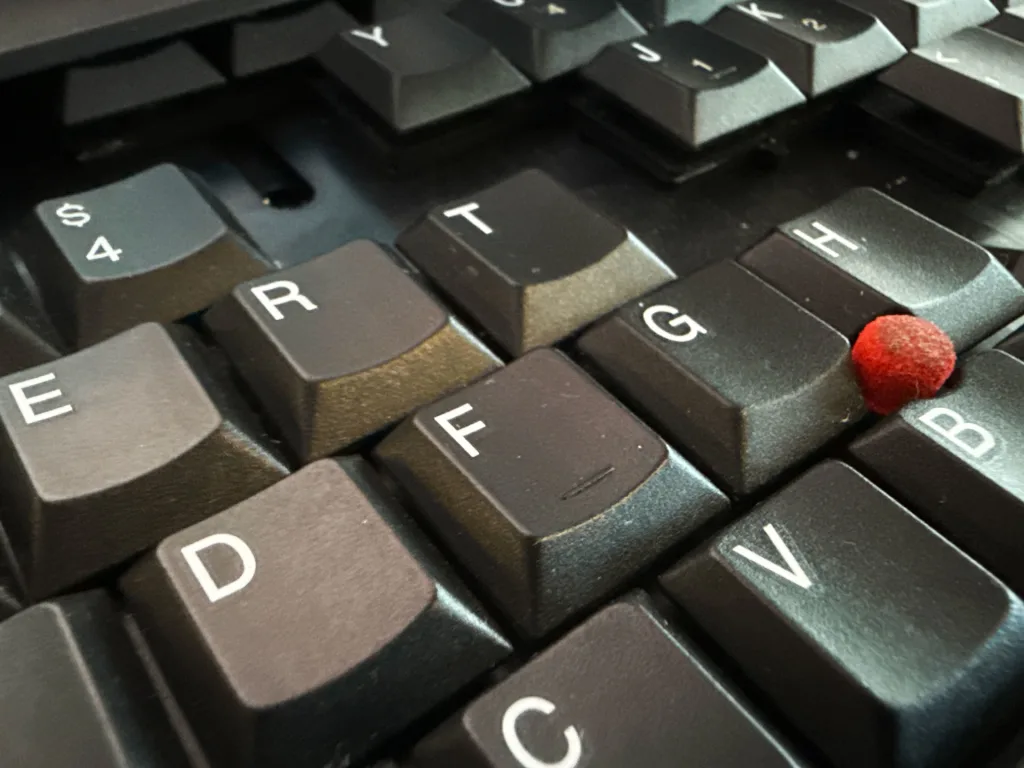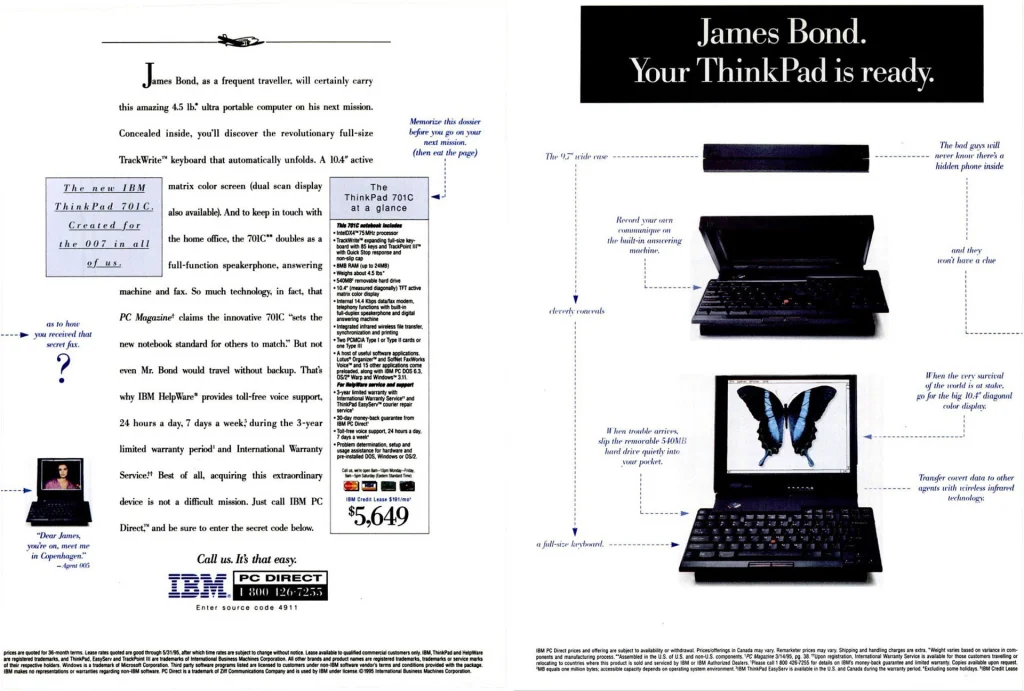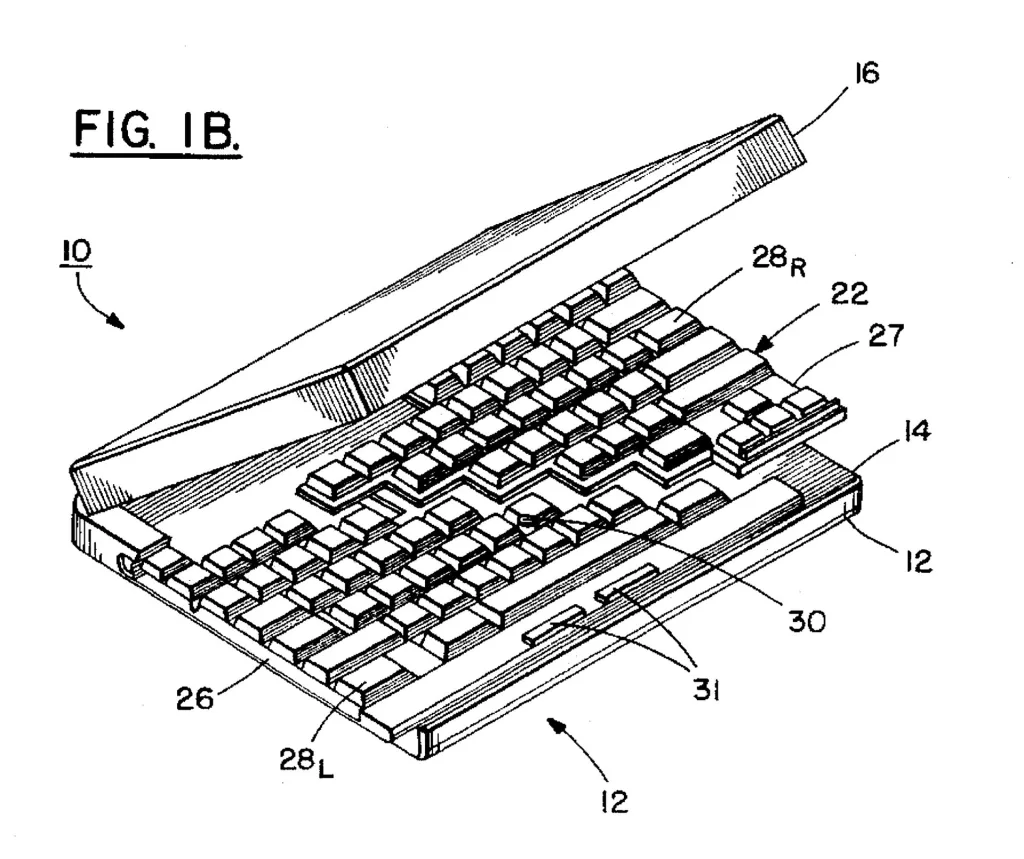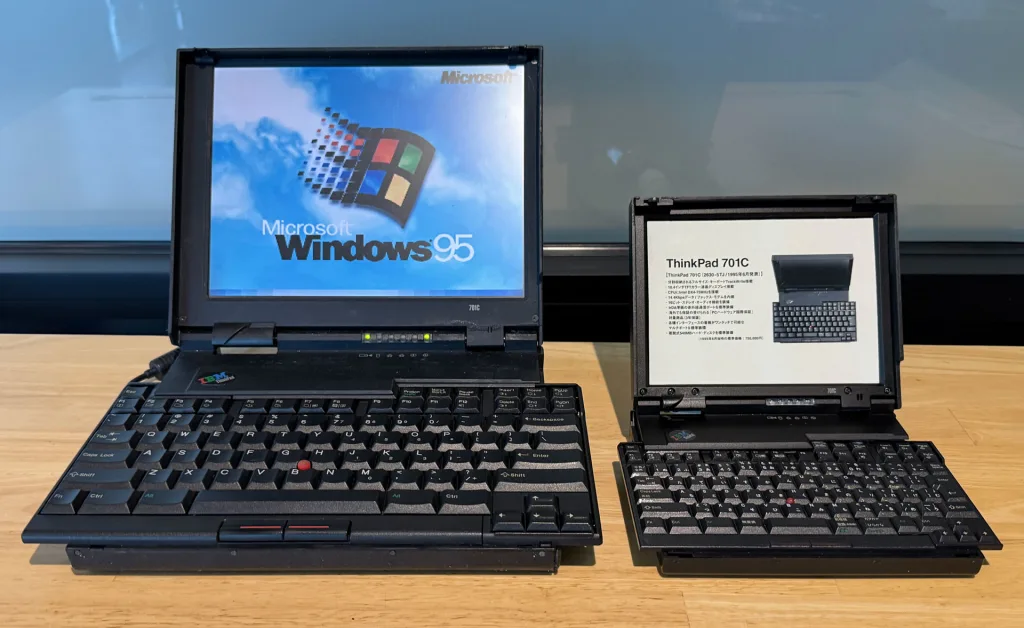Closed, it appears to be like just about like some other laptop computer manufactured in 1995.
To make certain, it’s extra compact than most—making it, within the parlance of the day, a subnotebook. Nevertheless it’s nonetheless comically thick, standing nearly as tall as 4 MacBook Airs stacked on one another. That peak is required to accommodate a number of applied sciences later rendered out of date by technological progress, equivalent to a dial-up fax/modem, an infrared port, two PCMCIA growth card slots, and a cumbersome connector for an exterior docking station.
However then you definitely open it up. And as you do, one thing totally distinctive occurs.
Thirty-five of the laptop computer’s keys glide out to the left in a cluster. One other 49 swivel downward and to the correct. By the point you’ve raised the display screen into place, these 84 keys have assembled themselves right into a keyboard that’s 11.5” vast—regardless that the laptop computer’s case is barely 9.7” vast. The result’s the holiest of Nineteen Nineties computing holy grails: cozy, no-compromises typing on a laptop computer that’s—once more, by the requirements of three many years in the past—extremely moveable.
This story is a part of 1995 Week, the place we’ll revisit among the most fascinating, surprising, and confounding developments in tech 30 years in the past.
I might solely be speaking about IBM’s ThinkPad 701, probably the most buzzworthy PC of 1995. Its increasing keyboard, formally known as the TrackWrite, stays higher identified by its code-name of “Butterfly,” referencing the spreading-wing-like impact because it slid into place. (IBM’s butterfly keyboard is to not be confused with Apple’s a lot later, famously wretched keyboard of the identical nickname.)
Most wonderful tech merchandise don’t keep wonderful without end. “Superb—for its time” is mostly nearly as good because it will get. However I don’t hesitate to explain the ThinkPad 701 as wonderful, full cease. It’s among the best issues the know-how trade has ever performed with shifting elements.
Although the idea could sound faintly Rube Goldbergian, it labored shockingly properly. Lifting the display screen set off a system of hid gears and levers that propelled the 2 sections of keyboard into place with balletic grace. As soon as assembled, there was no seen seam between the sections, and—regardless of the overhang they created on each side of the pc—no droop. Closing the lid neatly reversed the method.
Even the assured sound the keyboard produced because it slid out and in—someplace between a whirrrr and a whooosh, culminating in a satisfying click on—was pleasing to the ear, as if IBM had paid consideration to the acoustic expertise in its personal proper.
Most computer systems can be laborious to promote in a 15-second TV industrial. However all IBM needed to do was convey the ThinkPad 701’s petite dimension after which present what occurred if you opened it. Mission achieved, with time to spare.
Lengthy after the ThinkPad 701 left the market, it nonetheless felt like magic. David Hill, who turned the ThinkPad’s design chief in 1995 and continued within the function after IBM bought its PC division to Lenovo a decade later, stored one readily available to reveal to guests equivalent to faculty college students. “Each time I pulled that factor out and confirmed it to folks, the response can be the identical,” he remembers. “There can be this deafening silence. After which somebody would say, ‘Do it once more!’”
When the ThinkPad 701 was new, laptop computer consumers acknowledged it because the engineering marvel it was. A Businesweek article cited gross sales of 215,000 items and mentioned it was 1995’s best-selling PC laptop computer. But by the point that story appeared in February 1996, the 701 had been discontinued. IBM by no means made something prefer it once more. Neither did anybody else.
So how might a laptop computer extensively regarded to have solved considered one of cellular computing’s basic issues come and go so rapidly? Therein lies a story.
The subnotebook conundrum
In case you skim via sufficient images of typical laptops of the mid-Nineteen Nineties—such because the 65-plus fashions reviewed in an August 1993 PC Magazine cover story—two issues will strike you about their shows. First, they’re really dinky. Almost all those PC Magazine coated measured between 8.5” and 9.5” diagonally. Immediately, in contrast, most mainstream laptop computer screens begin at 13” and go up from there.
Secondly, most mid-Nineteen Nineties laptop computer screens are surrounded by overwhelmingly gigantic bezels, as in the event that they have been framed, matted images. From our Twenty first-century vantage level, they give the impression of being bizarre, since laptop makers later spent years shrinking the bezels down—each an aesthetic enchancment and a approach to match a roomier show in a smaller case. However by supersizing the bezels, ’90s producers gave themselves sufficient room to equip laptops with desktop-like keyboards. On the time, much more than now, that was a completely vital design aim.
The primary PC maker that found out tips on how to design a subnotebook-sized laptop computer with a desktop-sized keyboard would actually have one thing.
Now, there have been consumers who craved portability a lot that they have been keen to simply accept a shrunken keyboard. Subnotebooks catered to them. However these miniature laptops have been a unusual area of interest. Reviewing the ThinkPad 500, IBM’s first subnotebook, for InfoWorld in 1993, my buddy Fredric Paul concluded that “contact typing is feasible however not precisely enjoyable. A bit extra thought in regards to the correct kind issue might need allowed extra nice typing.”
Everybody else making subnotebooks confronted the identical problem. ”There was a mismatch between the largest-size display screen and a full dimension keyboard,” says Hill. “In case you needed to make one thing that basically hugged to the edges of the display screen, the keyboard needed to be considerably compromised when it comes to the flexibility to sort on it.”
It was apparent that the primary PC maker that found out tips on how to design a subnotebook-sized laptop computer with a desktop-sized keyboard would actually have one thing. Until, that’s, the entire thing was an unimaginable dream.
In 1992, design legend Richard Sapper had given the first ThinkPad its squared-off black case and pink TrackPoint pointing nub—parts which have confirmed so sturdy that they’re nonetheless with us in new ThinkPads from Lenovo. As IBM contemplated the subnotebook market, Sapper tinkered with strategies for getting massive keyboards into small laptops—“Folding the keyboard on prime of itself, with wings that might fold outward, and another concepts,” says Hill. “However they made the pc thicker. And that was not one thing that was standard.”

Impractical although the aim of a keyboard that expanded appeared, it continued to drift round inside IBM. Amongst these making an attempt to resolve it was John Karidis (1958-2012), an worker on the firm’s Yorktown Heights, New York, lab whom Hill calls “probably the most gifted mechanical engineer I’ve ever labored with in my complete profession.” His earlier initiatives at IBM had ranged extensively, from high-speed printers to chip testing tools.
Karidis “actually loved the cadre of inventors and makers,” say his brother, George Karidis—an inventor himself, as was their father, a nuclear engineer for Westinghouse. “He welcomed that [IBM] was Worldwide Enterprise Machines, and he and others made machines. He had a deep focus at a second’s discover on any subject. He didn’t have a concern of failure, however simply an eagerness to pursue issues.”
In the future, Karidis had the epiphany that made the ThinkPad 701 doable. “He was enjoying with some wood constructing blocks along with his daughter, and he seen that should you take two triangular blocks and slide them previous one another, it type of makes a rectangle that adjustments its side ratio,” says Hill. By breaking a keyboard into sections that slid, you would possibly have the ability to enhance its width with out resorting to a folding design that added to the pc’s peak.
To check that concept out, Karidis “ended up photocopying a keyboard after which slicing it out,” says his brother George. “He noticed the way it might translate. And he went house and confirmed it to his spouse, and he or she type of checked out him humorous and mentioned, ‘’They pay you to do that?’”
IBM used robots to confirm that the break up keyboard was strong sufficient to face up to 25,000 openings and closings.
In his 2017 ebook How the ThinkPad Modified the World and is Shaping the Future, Arimasa Naitoh, who led a ThinkPad engineering group in Yamato, Japan, for many years, writes of an IBM government on the firm’s Raleigh, North Carolina workplace. Studying of Karidis’s keyboard, he pushed a plan to include it in a laptop computer. That government, Naitoh says, was Tim Prepare dinner—years earlier than he joined Apple. Prepare dinner’s IBM obligations concerned manufacturing and distribution, not product growth, and he left the corporate properly earlier than the ThinkPad 701 was launched. Pondering of him as considered one of its fathers could also be going method past the documented proof. Nonetheless, the thoughts boggles: Essentially the most fascinating laptop computer Apple’s eventual CEO performed a hand in hatching won’t have been a MacBook.
Bringing Karidis’s brainstorm to market took time. In 1992, the corporate had shaped an analysts’ council that gave a choose group of trade watchers the chance to see merchandise beneath growth and supply suggestions. Its contributors included Artistic Methods analyst (and Fast Company contributor) Tim Bajarin; the group nonetheless exists immediately as a part of Lenovo’s PC enterprise and Bajarin stays a member.
At one assembly, the council acquired a preview of Karidis’s design—although not but in a working laptop computer. ”It wasn’t a real gadget, however they confirmed us the idea, confirmed us how the butterfly keyboard would possibly work,” explains Bajarin. “And by the way in which, they did actually good mockups. They weren’t cheapo stuff. To an individual, we mentioned, ‘If you are able to do it, it is best to do it.’”
They may do it, and did—simply not as quickly as they’d hoped. Naitoh writes that the ThinkPad 701 was initially speculated to ship by the top of 1994. It missed that deadline, delayed by the calls for of engineering and testing such an unprecedented product. For instance, IBM used robots to confirm that the break up keyboard was strong sufficient to face up to 25,000 openings and closings.
Mr. Bond’s laptop computer
On March 6, 1995, IBM lastly introduced its new subnotebook. Out there in a wide range of configurations, its listing costs ranged from $3,799–$5,649, or about $8,000–$11,900 in 2025 {dollars}—not low cost, however not absurd on the time. Essentially the most economical variant, the ThinkPad 701Cs, had a ten.4” display screen—roomy on the time—however it was a “passive matrix” LCD, which tended to depart colours wanting a tad washed out. The one you actually needed was the 701C, which sported a vivid active-matrix display screen of the identical dimension.
In a story in regards to the 701’s arrival, The New York Occasions’ Laurie Flynn mentioned that IBM might need bother maintaining with demand, partially as a result of it had gotten potential consumers too excited too early. She additionally famous that the 701 used “the older Intel 486 chip fairly than the quicker Pentium”—an artifact of its sluggish gestation that might come again to chunk IBM.
Reviewers, whom IBM had seeded with ThinkPad 701 items earlier than its launch, weren’t impressed by the laptop computer’s ageing processor and located its battery life iffy. Because of the butterfly keyboard, they nonetheless hailed the system as a cellular computing landmark. “The $5,000 ThinkPad 701C has efficiently taken the sub out of subnotebook,” wrote PC Journal’s Brian Nadel. The Wall Avenue Journal’s Walt Mossberg known as it “a real gem of a pc” and—more than 20 years later—“in all probability probably the most uncommon and, I believe, in some methods intelligent laptop computer I ever reviewed.”

Typically talking, IBM was a businesslike model and ThinkPad marketing leaned into sensible benefits. With the 701, nonetheless, the corporate wasn’t afraid of gadget-y associations. ”James Bond, as a frequent traveler, will definitely carry this wonderful 4.5 lb. extremely moveable laptop on his subsequent mission,” declared one advert, enjoying up options such because the built-in answering machine and fax functionality. That November, James Bond (Pierce Brosnan) actually did fool around with a 701 in GoldenEye—though solely fleetingly and to the obvious annoyance of Q. (Fittingly, Hill says that Karidis was often known as “the Q of IBM.”) The next 12 months, the pc additionally confirmed up briefly in Tom Cruise’s first Mission Inconceivable movie, which is best identified for its Apple product placement.
On this video promo shot at Disney World’s Epcot Heart,an IBM worker walks via the 701’s options. We additionally glimpse the tools the corporate used to check the pc and random theme park guests being impressed by the increasing keyboard.
The ThinkPad 701 garnered some weighty recognition, together with 27 design awards. It was even exhibited at New York Metropolis’s Museum of Trendy Artwork. However regardless of the publicity and plaudits, its clock ran out earlier than the 12 months ended. In a “Hardware Withdrawal” list launched on November 21, 1995, IBM introduced that it could cease advertising the 701 as of December 21. Items that had already made their method into distribution channels would stay obtainable into 1996, however the 701 was a lifeless laptop strolling, lower than 9 months after its debut.
A number of elements contributed to IBM’s resolution to discontinue such a high-profile system. Certainly one of them was its Intel 486 chip, which had felt a tad outdated when the 701 was launched and grown solely extra so by late 1995. Updating the design with a Pentium wouldn’t have been so simple as plopping in a more moderen processor. As an alternative, the choice would have set off a cascading collection of engineering challenges referring to maintaining the highly effective Pentium operating cool. Attainable, actually—but additionally a major enterprise.
“I must say that [the ThinkPad 701’s] greatest success is the halo that created round ThinkPad and IBM, as a result of it was so wildly artistic,” says Hill. “Nevertheless it did type of miss the wave when it comes to the announcement relative to the chip. So it was somewhat bit late.”
Bajarin notes that that IBM instructed members of its analysts’ council that the TrackWrite’s keyboard had some reliability points, since its left and proper edges overflowed the case and have been unsupported in use. That was very true amongst customers who mistreated their expensive new laptops: “Generally they’d throw it of their backpack with out getting the keyboard closed utterly,” he remembers.
The good widening
Finally, although, the ThinkPad 701 wasn’t performed in by its personal limitations. As moveable computer systems turned extra standard, progress in show know-how had made it doable for PC makers to make use of bigger screens. Producers have been additionally getting higher at becoming a laptop computer’s needed elements into much less house. These advances allow them to design a brand new technology of skinny, mild laptops that went past the constraints of subnotebooks. As soon as IBM might make a light-weight laptop computer with a wider display screen, “the necessity for an increasing keyboard was now not important,” says George Karidis. “It will have simply been a novelty.”
In his ebook, Naitoh writes that the 701 was launched amid rivalry between IBM’s Raleigh and Yamato groups that was resolved by centralizing ThinkPad growth in Yamato. Put answerable for figuring out the butterfly keyboard’s future, he reluctantly concluded its time had handed and suspended additional work on it.
In 1996, IBM launched the ThinkPad 560. Its 12.1” show was significantly roomier than the ThinkPad’s 701’s 10.4-incher. The case was two inches wider than the 701, providing loads of house for a desktop-like keyboard—no butterfly mechanism required. But the 560 was additionally a lot thinner (1.2”) and lighter (4 lb.) than the 701, attaining a kind issue that might turn out to be often known as “ultraportable.”

The ThinkPad 701 had been a memorable blip. The ThinkPad 560’s steadiness of portability, energy, and luxury presaged the place your complete trade would focus its power for years to return. The tip consequence has been laptops equivalent to immediately’s ThinkPad X1 Carbon Gen 13. With a 14” display screen, it’s 53% thinner at its thickest level and 46% lighter than the ThinkPad 560. “Lenovo continues to flatten these items to the purpose that it hardly even must be any thinner,” says Hill.
Although the 701’s butterfly keyboard couldn’t survive on coolness alone, “There have been a few makes an attempt to deliver it again with different working methods, like a type of a sensible ebook type of gadget or different issues of that nature, however we by no means might get the the traction,” says Hill. “In actual fact, John [Karidis] and I labored on one the place solely half the keyboard moved.” Even now, it might be untimely to imagine the thought won’t ever resurface in a brand new gadget: In 2021, the historical past web site Laptop computer Retrospective reported that Lenovo had filed a brand new patent for a magnetic increasing keyboard, presumably to be used with tablets.
Interviewed by Cnet’s John G. Spooner in 2001, Karidis didn’t appear haunted by his invention’s failure to vary computing in any everlasting method. ”The butterfly keyboard was now not needed, as a result of folks moved to bigger shows, particularly on this geography,” he instructed Spooner. “The place the butterfly method is smart is the place you need the biggest keyboard doable together with an 8-inch or 10-inch show. We’ll wait and see whether or not the market want develops (once more) for that.” Thus far, it hasn’t—however it’s enjoyable to assume it might.
Butterflies are without end
Again in 1995, I didn’t even contemplate shopping for a ThinkPad 701. Even in its most cost-effective configuration, it was far, far outdoors my value vary. Each of my mother and father acquired ones as work machines, although. I recall Ma and Pa McCracken being very proud of their hers-and-his ThinkPads, though my mom, who principally used hers on the sofa when working from house, found that extra cat hair clogged the keyboard mechanism.
Whereas engaged on this text, I noticed I wanted to reacquaint myself with the 701 in particular person. I ended up snagging one off eBay. Its TrackWrite keyboard continues to perform completely, and it nonetheless boots into Home windows 95. Nevertheless, like many 30-year-old laptops, mine has fallen sufferer to its superior age. It has a corroded battery, a flaky energy swap, and a case whose rubberized black coating has decomposed to a syrupy consistency.

A ThinkPad 701 proprietor who goes by the net deal with of Polymatt hasn’t simply lovingly restored his personal laptop computer. He’s created Project Butterfly, a web site filled with step-by-step restore guides: Methods to sand and repaint its case, 3D-print substitute elements, fabricate a substitute battery, and extra. All the things is open supply, together with information that enable the printing of substitute decals for icons equivalent to those indicating the laptop computer’s energy swap, printer port, headphone jack, and different options.
Like me, Polymatt is a second-generation fan whose father introduced a 701 house throughout its unique second of glory. “I used to be immediately interested in it,” he says. “He had some earlier ThinkPads, however this factor was simply supercool. I’ve actually fond reminiscences of enjoying video video games on it and simply being fascinated by what it was. It helped cement my curiosity in know-how.” The 701 lingered in his reminiscence. Years later, it resurfaced as a possibility to contribute one thing significant to the neighborhood of classic computing lovers.
As a factor of marvel, the ThinkPad 701 continues to transcend its personal obsolescence.
Polymatt isn’t the one 701 proprietor who’s gone all out to deliver the machine into the Twenty first century. Karl Buchka managed to replace a 701’s guts with the motherboard from a modern Framework modular laptop and provides it an iPad’s Retina show. Theoretically, an intrepid modder might do one thing comparable with any outdated laptop. It’s simply that few mid-90s laptops stay fascinating sufficient to encourage such creativity.
Solely a small group of hackers have the endurance, ardour, and technical chops to accumulate a ThinkPad 701—Polymatt says he’s had 20 or 30 through the years—and repair it up. However a far bigger swath of humanity remains to be charmed by John Karidis’s butterfly keyboard. YouTube is awash in 701-related movies, from an excellent documentary to folks simply being entranced by it. As a factor of marvel, it continues to transcend its personal obsolescence.
Simply by itself, Polymatt’s YouTube Short of a 701 opening and closing has been seen greater than 600,000 instances. “The enjoyable factor is, I see the feedback coming in from individuals who assume that it’s a contemporary factor and are enthusiastic about it,” he says. “After which I see individuals who comprehend it and are like, ‘Oh, they should deliver this again.’ I get the entire spectrum of reactions.”
Sure, among the YouTube commenters helpfully level out that the appearance of vast screens way back eradicated the necessity for an increasing keyboard. Even so, it’s robust to look at the video simply as soon as after which click on away. In any case these years, probably the most pure response to seeing the ThinkPad 701 in motion stays “Do it once more.”


